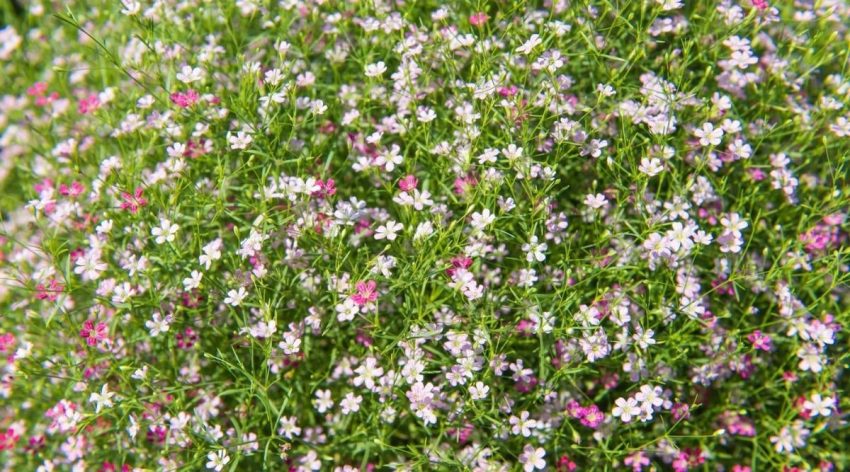langerhanscellhistiocytosis.org – Baby’s Breath, scientifically known as Gypsophila paniculata, is a charming and versatile flower that has captured the hearts of gardeners and florists for centuries. With its airy, cloud-like clusters of tiny white blooms, Baby’s Breath is often used as a filler in floral arrangements, but its beauty stands on its own in the garden as well. This hardy, low-maintenance plant is admired for its subtle elegance and delicate presence.
Appearance and Characteristics
Baby’s Breath is a perennial flower that grows in a bushy, upright form. It typically reaches heights of 2 to 3 feet (60 to 90 cm) and spreads about 18 to 24 inches (45 to 60 cm) wide. The plant is covered with fine, green stems and small, lance-shaped leaves, which provide a soft backdrop for the profusion of tiny, star-shaped white flowers that emerge in the summer. These clusters of white blossoms appear in delicate sprays, giving the plant an ethereal, mist-like appearance.
In addition to the classic white variety, Baby’s Breath is also available in soft pink and occasionally purple blooms. These colorful varieties are just as beautiful and add a touch of variety to the traditional look. The flowers of Baby’s Breath have a subtle fragrance, which, combined with their lightness, makes them a popular choice in bouquets, especially for weddings and other romantic occasions.
Growing Conditions and Care
Baby’s Breath thrives in full sun and prefers well-drained, slightly alkaline soil. It is drought-tolerant and can survive in dry conditions once established, making it an ideal choice for xeriscaping or low-water gardens. The plant is hardy in USDA zones 3 through 9, which means it can withstand a variety of climates, from cooler northern areas to warmer southern regions.
This plant is relatively easy to grow and requires minimal care. For optimal growth, Baby’s Breath should be planted in an area that receives at least 6 hours of direct sunlight per day. While it can tolerate poor soil, it will benefit from moderate fertilization in the spring to encourage robust flowering.
Regular deadheading (removing spent blooms) will help extend the flowering season and keep the plant looking tidy. Pruning back the plant after its first flowering can encourage a second bloom later in the season. Baby’s Breath is generally resistant to pests and diseases, making it a low-maintenance addition to any garden.
Uses in the Garden and Floral Arrangements
Baby’s Breath is a versatile plant in the garden and has many uses. It is often planted in borders, flower beds, and along pathways where its delicate flowers can create a soft contrast with bolder plants. The plant also makes an excellent ground cover, filling in gaps and providing a cushion of white blooms that contrast beautifully with other colorful flowers.
In addition to its garden uses, Baby’s Breath is a popular addition to floral arrangements. It’s commonly used in bouquets, especially for weddings, where its delicate and airy nature complements larger, more dramatic flowers like roses, lilies, or tulips. Its soft, white blooms convey a sense of purity and innocence, making it a symbolic flower in many cultures. Baby’s Breath is often associated with everlasting love, making it a perfect flower for weddings, anniversaries, and other celebrations of love.
Symbolism and Cultural Significance
Baby’s Breath carries significant symbolism in various cultures. It is often associated with purity, innocence, and everlasting love, which is why it is frequently used in bridal bouquets and other romantic celebrations. In some traditions, Baby’s Breath represents the idea of eternal love, making it a meaningful flower for expressing affection and devotion.
The flower also symbolizes a sense of simplicity and grace, embodying a quiet beauty that is both humble and timeless. In many ways, Baby’s Breath is the epitome of understated elegance, often included in arrangements to highlight the beauty of the other flowers.
Conclusion
Baby’s Breath is a timeless and graceful flower that offers a sense of tranquility and purity to any garden or floral arrangement. Whether used as a filler in bouquets or grown as a standalone plant, its delicate white blossoms are sure to bring a soft, elegant touch to any setting. Easy to grow and care for, Baby’s Breath is a versatile choice for both novice and experienced gardeners alike. With its long-lasting blooms and symbolic meaning, this charming flower continues to be a beloved favorite in gardens and floral designs across the world.

